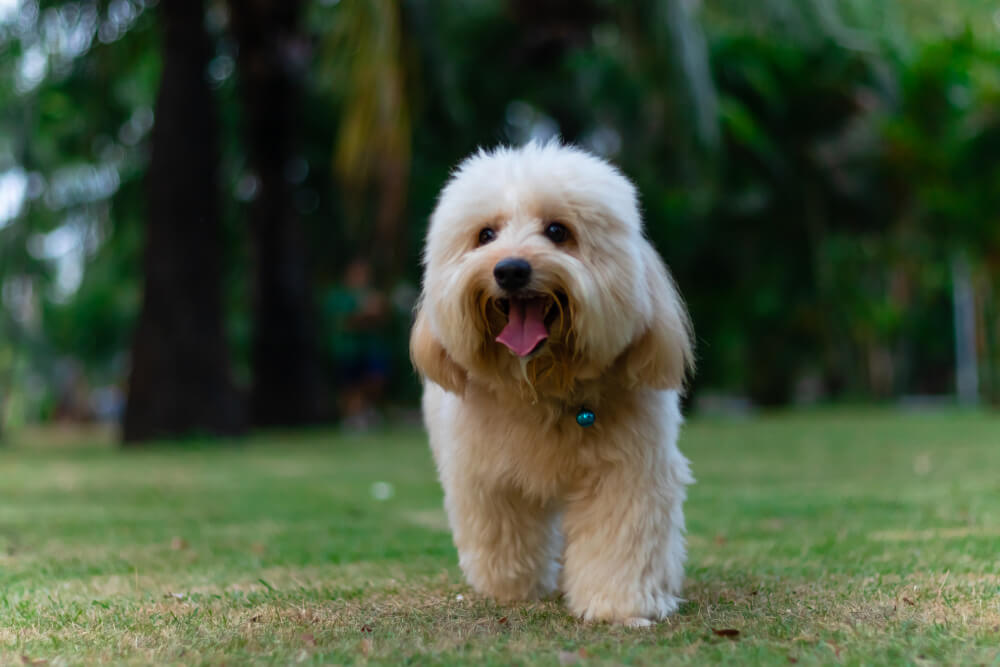How Long Will My Dog Live?

Table of Contents
Listen To The Article
Introduction to How Long Will My Dog Live?
There is no question that dogs are man’s best friend.
They are considered to be babies with fur and are pretty much always there for you.
However, one day you will inevitably have to say goodbye to your best friend.
When that day comes, you will be left with many questions.
When will my dog die?
What age will he die at?
Is it going to be painful?
Will I be able to say goodbye?
These are just a few of the questions that you will start to ask yourself as your precious pet moves closer to death.
So, to help you out, we have compiled a list of the common age ranges that you can expect your dog to live up to.
Sadly, we don’t have a crystal ball to tell us how long our dogs will live.
If we could, do you think we would have to wait until our furry companions passed away to find out how long they lived?
All we can do is make educated guesses based on current studies, and we can certainly do that!
Dog ownership is one of the great joys of life.
Our furry friends provide us with unconditional love, companionship, and more smiles than can be counted.
There are pitfalls associated with dog ownership, however.
We can deal with the messes and other passing aggravations; it’s undeniable that people live longer than dogs that eventually bring most owners to tears.
Thinking about the inevitable loss of a beloved pet often compels owners to ask, how long will my dog live?
Of course, there is no way to specifically answer that question when it comes to a particular individual, but averages are available for many well-known breeds, including the Golden Retriever, Bulldog, Dachshund, German Shepherd, and Pug.

What Determines A Dog’s Lifespan?
The most crucial among them are breed and size, however, genetics, health, and overall lifestyle also have a huge impact on a beloved companion’s mortality.
Size
A broad study on canine lifespan from 2010 reveals that on 14 examined long-living breeds, 64% were small-sized dogs, 21% were a toy and 14% were moderate-sized dogs.
To receive as credible results as possible, the scientists studied 56,000 animals, including over 70 dog breeds.
They found out that the dog’s mortality is significantly linked to their weight the dog which weights more will live shorter than a lighter one.
Some experts also believe that large breeds age faster because they are prone to heart diseases.
Breed
A dog breed is highly connected to its genetics. Purebred dogs have a smaller genetic pool and less variation in it.
The breeding always takes place under a controlled environment, so the susceptible genes tend to stay in the breed.
10% of all occurring illnesses are genetic, therefore purebred dogs are more prone to them.
Crossbred canines, however, tend to live longer than purebred dogs.
Mix-breeds have stronger immune systems, therefore, they experience fewer health problems.
A 2018 Japanese study on 5,100 representatives of different dog breeds proves that the average mutt enjoys longer life by 1.2 years longer than their purebred canine.
Diet
Providing a healthy, well-balanced diet to your dog can increase their expected lifespan significantly.
Additionally, it might have a positive impact on the quality of their life and delay the aging process.
Overweight is a huge enemy of a healthy lifestyle so keep in mind the number of treats you give your dog and reduce it from the daily ratio.
Daily Care
How long will my dog live?
If you provide a nutritious diet and the right amount of exercise and training, the chances are that they will enjoy a long happy life with you.
Take your best friend regularly for check-ups and don’t forget about dental care.
Mental stimulation can impact your dog’s well-being as much as physical exercise.
You can easily combine both by trying out dog tricks and games to build a stronger bond with your four-pawed companion and spend valuable time together.
A healthy and loved dog is a happy dog.
Take the most of your time together and enjoy every single day in each other’s company.
Spayed Or Neutered
Spaying and neutering a puppy at a relatively young age can positively affect a dog’s lifespan.
Most studies recommend surgical sterilization before five months of age for small breed dogs and 12-15 months for large breed house dogs.

Average Life Expectancy By Breed
Lifespan also depends on the dog breed. Mainly because some animals are prone to contracting breed-specific diseases and conditions. Smaller breeds tend to live longer.
| Breed | Average Lifespan (Years) |
| Affenpinscher | 12 to 14 |
| Afghan Hound | 12 to 14 |
| African Boerboels | 9 to 11 |
| Airedale Terrier | 10 to 13 |
| Akbash | 10 to 11 |
| Akita | 10 to 13 |
| Alapaha Blue Blood Bulldogs | 13 |
| Alaskan Klee Kai | 14 |
| Alaskan Malamute | 10 to 13 |
| American Bulldog | 12 to 14 |
| American Eskimo Dog | 12 to 14 |
| American Foxhound | 10 to 13 |
| American Staffordshire Terrier | 12 to 14 |
| American Water Spaniel | 10 to 12 |
| Anatolian Shepherd Dog | 10 to 13 |
| Australian Cattle Dog | 10 to 13 |
| Australian Kelpie | 12 |
| Australian Shepherd | 12 to 15 |
| Australian Silky Terrier | 11 to 14 |
| Australian Terrier | 12 to 14 |
| Basenji | 12 to 14 |
| Basset Hound | 11 to 14 |
| Beagle | 12 to 14 |
| Bearded Collie | 12 to 14 |
| Beauceron | 10 to 12 |
| Bedlington Terrier | 12 to 14 |
| Belgian Malinois | 10 to 12 |
| Belgian Shepherd Dog | 10 to 12 |
| Belgian Tervuren | 10 to 12 |
| Bernese Mountain Dog | 6 to 9 |
| Bichon Frise | 12 to 15 |
| Black and Tan Coonhound | 10 to 12 |
| Black Russian Terrier | 10 to 11 |
| Bloodhound | 10 to 12 |
| Border Collie | 10 to 14 |
| Border Terrier | 12 to 15 |
| Borzoi | 10 to 12 |
| Boston Terrier | 14 |
| Bouvier des Flandres | 10 to 12 |
| Boxer | 8 to 10 |
| Briard | 10 to 12 |
| Brittany | 12 to 13 |
| Brussels Griffon | 12 to 15 |
| Bull Terrier | 11 to 14 |
| Bullmastiff | 8 to 10 |
| Cairn Terrier | 12 to 14 |
| Canaan Dog | 12 to 13 |
| Cane Corso | 11 |
| Cardigan Welsh Corgi | 12 to 14 |
| Carolina Dog | 13 |
| Catahoula Leopard Dogs | 12 |
| Cavalier King Charles Spaniel | 9 to 14 |
| Central Asian Ovtcharkas | 12 |
| Cesky Terrier | 14 |
| Chesapeake Bay Retriever | 10 to 13 |
| Chihuahua | 14 to 18 |
| Chinese Crested | 13 to 15 |
| Chinese Foo | 11 |
| Chinese Shar-Pei | 8 to 10 |
| Chipoo | 14 |
| Chow Chow | 8 to 12 |
| Clumber Spaniel | 10 to 12 |
| Cocker Spaniel | 12 to 15 |
| Cockapoo | 14 to 18 |
| Collie | 8 to 12 |
| Coton De Tulears | 15 |
| Curly-Coated Retriever | 8 to 12 |
| Dachshund | 12 to 14 |
| Dalmatian | 12 to 14 |
| Dandie Dinmont Terrier | 11 to 13 |
| Doberman Pinscher | 10 to 12 |
| Dogue de Bordeaux | 5 to 7 |
| English Bulldogs | 8 to 12 |
| English Cocker Spaniels | 12 to 14 |
| English Foxhound | 10 to 13 |
| English Setter | 10 to 12 |
| English Shepherd | 15 |
| English Springer Spaniel | 10 to 14 |
| English Toy Spaniel | 10 to 12 |
| Estrela Mountain Dogs | 11 |
| Field Spaniel | 12 to 14 |
| Fila Brasileiros | 10 |
| Finnish Spitz | 12 to 14 |
| Flat-Coated Retriever | 10 to 13 |
| Fox Terrier (Smooth) | 10 to 13 |
| Fox Terrier (Wire) | 10 to 13 |
| French Bulldog | 9 to 11 |
| German Pinscher | 12 to 15 |
| German Shepherd | 10 to 12 |
| German Shorthaired Pointer | 12 to 14 |
| German Wirehaired Pointer | 12 to 14 |
| Giant Schnauzer | 10 to 12 |
| Glen of Imaal Terrier | 10 to 14 |
| Golden Retriever | 10 to 13 |
| Goldendoodle | 14 |
| Gordon Setter | 10 to 12 |
| Great Dane | 7 to 10 |
| Great Pyrenees | 10 to 12 |
| Greater Swiss Mountain Dog | 10 to 12 |
| Greyhound | 10 to 13 |
| Harrier | 12 to 14 |
| Havanese | 12 to 14 |
| Hungarian Vizsla | 10 to 14 |
| Ibizan Hound | 12 to 14 |
| Irish Setter | 12 to 14 |
| Irish Terrier | 12 to 15 |
| Irish Water Spaniel | 10 to 13 |
| Irish Wolfhound | 5 to 7 |
| Italian Greyhound | 12 to 15 |
| Jack Russell Terrier | 13 |
| Japanese Chin | 12 to 14 |
| Keeshond | 12 to 14 |
| Kerry Blue Terrier | 12 to 15 |
| Komondor | 10 to 12 |
| Kooikerhondje | 13 |
| Kuvasz | 9 to 12 |
| Labradoodle | 13 |
| Labrador Retriever | 10 to 12 |
| Laekenois | 12 |
| Lakeland Terrier | 12 to 16 |
| Lancashire Heeler | 14 |
| Lhasa Apso | 12 to 14 |
| Löwchen | 13 to 15 |
| Maltese | 12 to 14 |
| Maltipoo | 13 |
| Manchester Terrier | 15 to 16 |
| Maremma Sheepdog | 12 |
| Mastiff | 9 to 11 |
| Miniature Bull Terrier | 11 to 14 |
| Miniature Pinscher | 12 to 14 |
| Miniature Poodle | 12 to 14 |
| Miniature Schnauzer | 12 to 14 |
| Neapolitan Mastiff | 8 to 10 |
| Newfoundland | 8 to 10 |
| Norfolk Terrier | 13 to 15 |
| Norwegian Buhunds | 11 to 13 |
| Norwegian Elkhound | 10 to 12 |
| Norwich Terrier | 13 to 15 |
| Nova Scotia Duck Tolling Retriever | 11 to 13 |
| Old English Sheepdog | 10 to 12 |
| Otterhound | 10 to 13 |
| Papillon | 12 to 15 |
| Parson Russell Terrier | 13 to 15 |
| Peekapoo | 13 |
| Pekingese | 12 to 15 |
| Pembroke Welsh Corgi | 11 to 13 |
| Petit Basset Griffon Vendeen | 11 to 14 |
| Pharaoh Hound | 11 to 14 |
| Pit Bull | 12 to 14 |
| Plott | 11 to 13 |
| Pointer | 11 to 15 |
| Polish Lowland Sheepdog | 10 to 14 |
| Pomapoo | 13 |
| Pomeranian | 12 to 16 |
| Poodle (Standard) | 12 to 15 |
| Portuguese Water Dog | 10 to 14 |
| Pug | 12 to 15 |
| Puli | 10 to 15 |
| Rat Terrier | 16 |
| Redbone Coonhound | 11 |
| Rhodesian Ridgeback | 10 to 12 |
| Rottweiler | 8 to 11 |
| Saint Bernard | 8 to 10 |
| Saluki | 12 to 14 |
| Samoyed | 10 to 12 |
| Schipperke | 13 to 15 |
| Schnoodle | 13 |
| Scottish Deerhound | 7 to 9 |
| Scottish Terrier | 11 to 13 |
| Sealyham Terrier | 11 to 13 |
| Shetland Sheepdog | 12 to 14 |
| Shiba Inu | 12 to 15 |
| Shih Tzu | 11 to 14 |
| Siberian Husky | 11 to 13 |
| Silky Terrier | 11 to 14 |
| Skye Terrier | 12 to 14 |
| Snorkie | 12 |
| Soft-coated Wheaten Terrier | 12 to 14 |
| Spinone Italiano | 12 to 14 |
| Staffordshire Bull Terrier | 12 to 14 |
| Standard Schnauzer | 12 to 14 |
| Sussex Spaniel | 11 to 13 |
| Swedish Vallhund | 13 |
| Thai Ridgeback | 12 |
| Tibetan Mastiff | 11 to 14 |
| Tibetan Spaniel | 14 |
| Tibetan Terrier | 12 to 15 |
| Toy Fox Terrier | 13 to 14 |
| Toy Manchester Terrier | 14 to 16 |
| Toy Poodle | 12 to 14 |
| Treeing Walker Coonhound | 12 to 13 |
| Vizsla | 10 to 14 |
| Weimaraner | 10 to 13 |
| Welsh Springer Spaniel | 12 to 15 |
| Welsh Terrier | 12 to 14 |
| West Highland White Terrier | 12 to 14 |
| Whippet | 12 to 15 |
| Wirehaired Pointing Griffon | 12 to 14 |
| Xoloitzcuintle | 13 |
| Yorkie-Poo | 14 |
| Yorkshire Terrier | 14 to 16 |

Common Signs of Aging in Dogs
The number of years lived is not an ideal determinant of aging, especially when it comes to dogs.
Mainly because a 9-year-old Chihuahua is usually quite active while a Great Dane at that age would be highly lethargic and show definite signs of aging.
Identifying the signs of aging is quite important as it helps pet parents to add special supplements, regulate exercise duration, and increase the frequency of veterinary visits.
To help you smoothly transition from regular dog care to specialized elderly care, here’re the most common signs of aging in dogs.
Cloudy Eyes/Vision Problems
A general deterioration of vision and cloudy haze over the dog’s eyes.
Frequent Urination
Increased frequency of urination is often an indication of kidney-related health issues, which usually affect elderly dogs.
Confusion
A change in behavior, which generally includes short-tempered nature, dementia, and confusion.
Difficulty Getting Up
Health issues such as arthritis, hip dysplasia are common among elderly dogs, which often make it difficult for them to get up.
Weight Gain/Loss
Due to changes in the metabolic rate, thyroid-related issues, or dietary insufficiency elderly dogs can become overweight or underweight.
General Lethargy
Much like humans, elderly dogs increasingly become lethargic with age. They are often reluctant to play and run around.
Fatty Lumps
Elderly dogs often develop fatty lumps on their skin called lipomas. These are benign and painless tumors that usually affect old dogs.
Frequent and Deeper Sleep
Elderly dogs can spend a lot of time sleeping. Often unresponsive to sounds and disturbances they usually experience a deeper slumber.

Converting Dog Years Into Human Years
As much as we want them, dogs simply do not live as long as humans.
Unfortunately, this means we often are forced to endure the heartbreak of dealing with the death of our beloved pets.
Now, you may have heard that 1 dog year equals 7 human years.
However, that formula delivers a casual approximation at best.
There are more than a few factors that can determine the lifespan of a dog.
The size of the animal is an important determinant.
It’s seen that smaller dogs usually live longer than large breeds. It’s also important to note that a dog reaches maturity much faster.
In terms of rate of maturity, a dog’s 1st year is more like 15 years for humans.
A good approach to convert dog years to human years is to find out the average lifespan of the breed and the average life expectancy of humans in your country.
If you own an Akita in Japan, then your dog’s 1 year equals your 6.9 years
(Average human life expectancy in Japan is 83.1 years and the dog breed Akita has an average lifespan of 12)
If you own a Rottweiler in The United States, then your dog’s 1 year equals your 8.7 years
(Average human life expectancy in the US is 78.74 years and the dog breed Rottweiler has an average lifespan of 9 years)

What Is The Longest Living Dog Breed?
Chihuahuas usually are referred to as the breed with the longest lifespan.
They average 15-20 years and are one of the smallest dog breeds.
The oldest Chihuahua on record2, Megabyte, died at the age of 20 years and 265 days.
The Australian Cattle Dog is known for having one of the longest life expectancies.
There are records of Australian Cattle Dogs living past 20 years old.
In fact, the longest living dog recorded is an Australian Cattle Dog named Bluey, who lived 29 years and five months.

Factors Influencing Life Expectancy Of Dogs
As a responsible pet parent, your primary goal is to ensure your dog lives a happy, healthy, and long life.
Now, you already know that the life expectancy of dogs depends on the size and specific breed.
However, there are some factors you can control that may increase your dog’s lifespan.
Simple habits and effective medical care can work in favor of your dog’s health by boosting its immunity and keeping diseases at bay.
While death is an inevitable climax of all life, you can do your part to ensure your dog remains active and healthy for as long as possible.
This is exactly why we bring you our list of 7 factors that can influence the life expectancy of dogs.
Eliminate Overfeeding
If you think feeding your dog a ‘little’ more won’t hurt then think again.
Obesity makes dogs susceptible to heart diseases and other life-threatening conditions.
According to a study, Labradors fed 25% less lived at an average of 2 years longer than dogs who were given more food.
Get Them Neutered
Neutering helps in warding off certain life-threatening diseases and can potentially increase your dog’s lifespan by 1 to 3 years.
This simple medical procedure can keep diseases such as testicular cancer, uterine cancer, breast cancer, and prostate problems at bay.
Keep Your Dog’s Teeth Healthy
Poor dental health can potentially release harmful bacteria into the dog’s bloodstream.
Maintain a proper dental care routine using proper dog toothpaste and brush.
Give Them The Regular Dose of Exercise
Talk to a veterinarian to find out how much exercise your dog needs.
A daily dose of exercise keeps the heart healthy and boosts immunity.
Take Them to the Vet for Regular Check-ups
Early detection of illnesses can prove to be the difference between life and death.
Take your pet to the vet at least once every 6 months for thorough check-ups.
Don’t Create a Stressful Atmosphere
Keep your dog protected from factors that induce panic and stress.
This will reduce the secretion of stress hormones and help boost immunity.
Don’t Buy Questionable Dietary Products and Supplements
Buy supplements and dog food that are manufactured by reputed pet care companies.



